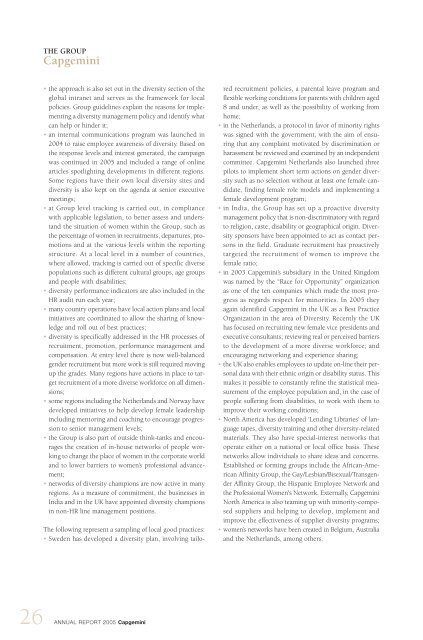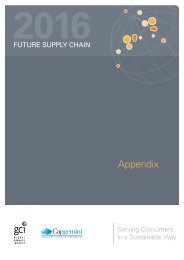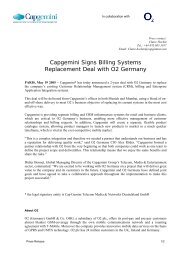Create successful ePaper yourself
Turn your PDF publications into a flip-book with our unique Google optimized e-Paper software.
26 ANNUAL<br />
THE GROUP<br />
<strong>Capgemini</strong><br />
• the approach is also set out in the diversity section of the<br />
global intranet and serves as the framework for local<br />
policies. Group guidelines explain the reasons for implementing<br />
a diversity management policy and identify what<br />
can help or hinder it;<br />
• an internal communications program was launched in<br />
2004 to raise employee awareness of diversity. Based on<br />
the response levels and interest generated, the campaign<br />
was continued in <strong>2005</strong> and included a range of online<br />
articles spotlighting developments in different regions.<br />
Some regions have their own local diversity sites and<br />
diversity is also kept on the agenda at senior executive<br />
meetings;<br />
• at Group level tracking is carried out, in compliance<br />
with applicable legislation, to better assess and understand<br />
the situation of women within the Group, such as<br />
the percentage of women in recruitments, departures, promotions<br />
and at the various levels within the reporting<br />
structure. At a local level in a number of countries,<br />
where allowed, tracking is carried out of specific diverse<br />
populations such as different cultural groups, age groups<br />
and people with disabilities;<br />
• diversity performance indicators are also included in the<br />
HR audit run each year;<br />
• many country operations have local action plans and local<br />
initiatives are coordinated to allow the sharing of knowledge<br />
and roll out of best practices;<br />
• diversity is specifically addressed in the HR processes of<br />
recruitment, promotion, performance management and<br />
compensation. At entry level there is now well-balanced<br />
gender recruitment but more work is still required moving<br />
up the grades. Many regions have actions in place to target<br />
recruitment of a more diverse workforce on all dimensions;<br />
• some regions including the Netherlands and Norway have<br />
developed initiatives to help develop female leadership<br />
including mentoring and coaching to encourage progression<br />
to senior management levels;<br />
• the Group is also part of outside think-tanks and encourages<br />
the creation of in-house networks of people working<br />
to change the place of women in the corporate world<br />
and to lower barriers to women’s professional advancement;<br />
• networks of diversity champions are now active in many<br />
regions. As a measure of commitment, the businesses in<br />
India and in the UK have appointed diversity champions<br />
in non-HR line management positions.<br />
The following represent a sampling of local good practices:<br />
• Sweden has developed a diversity plan, involving tailo-<br />
REPORT <strong>2005</strong> <strong>Capgemini</strong><br />
red recruitment policies, a parental leave program and<br />
flexible working conditions for parents with children aged<br />
8 and under, as well as the possibility of working from<br />
home;<br />
• in the Netherlands, a protocol in favor of minority rights<br />
was signed with the government, with the aim of ensuring<br />
that any complaint motivated by discrimination or<br />
harassment be reviewed and examined by an independent<br />
committee. <strong>Capgemini</strong> Netherlands also launched three<br />
pilots to implement short term actions on gender diversity<br />
such as no selection without at least one female candidate,<br />
finding female role models and implementing a<br />
female development program;<br />
• in India, the Group has set up a proactive diversity<br />
management policy that is non-discriminatory with regard<br />
to religion, caste, disability or geographical origin. Diversity<br />
sponsors have been appointed to act as contact persons<br />
in the field. Graduate recruitment has proactively<br />
targeted the recruitment of women to improve the<br />
female ratio;<br />
• in 2003 <strong>Capgemini</strong>’s subsidiary in the United Kingdom<br />
was named by the “Race for Opportunity” organization<br />
as one of the ten companies which made the most progress<br />
as regards respect for minorities. In <strong>2005</strong> they<br />
again identified <strong>Capgemini</strong> in the UK as a Best Practice<br />
Organization in the area of Diversity. Recently the UK<br />
has focused on recruiting new female vice presidents and<br />
executive consultants; reviewing real or perceived barriers<br />
to the development of a more diverse workforce; and<br />
encouraging networking and experience sharing;<br />
• the UK also enables employees to update on-line their personal<br />
data with their ethnic origin or disability status. This<br />
makes it possible to constantly refine the statistical measurement<br />
of the employee population and, in the case of<br />
people suffering from disabilities, to work with them to<br />
improve their working conditions;<br />
• North America has developed ‘Lending Libraries’ of language<br />
tapes, diversity training and other diversity-related<br />
materials. They also have special-interest networks that<br />
operate either on a national or local office basis. These<br />
networks allow individuals to share ideas and concerns.<br />
Established or forming groups include the African-American<br />
Affinity Group, the Gay/Lesbian/Bisexual/Transgender<br />
Affinity Group, the Hispanic Employee Network and<br />
the Professional Women's Network. Externally, <strong>Capgemini</strong><br />
North America is also teaming up with minority-composed<br />
suppliers and helping to develop, implement and<br />
improve the effectiveness of supplier diversity programs;<br />
• women’s networks have been created in Belgium, Australia<br />
and the Netherlands, among others.















